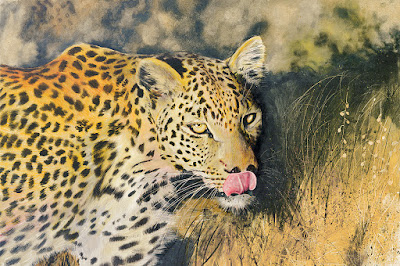 For the next paintings in my wild animal series I changed my surface to a watercolor board. Watercolor papers tend to buckle when wet, but this product has the premium paper surface mounted to a thick acid-free backing board. It stays flat while being painted but has all the qualities of that bring me joy when painting with watercolors. Actually, for these two paintings I chose to paint in fluid acrylic paints, using them in a transparent manner, so the effect is like using watercolors. “The Big Cat Nap” is group of sleepy lionesses, and it is a mate to my leopard painting “Satisfaction”, each measuring 30″ x 20″. They have similar tones and a mottled background for an out-of-focus appearance, keeping the emphasis on the animals themselves. Satisfaction was an award-winner for me, in an exhibit of the Florida Watercolor Society. Both originals are beautifully framed with a tan suede mat and distressed gold frame, selling for $850 each (or the pair for $1500). I also created giclee prints on paper of Satisfaction, in the same size as the original painting for $350 and 14″ x 10″ framed with a suede mat and carved gold leafed frame for $125 or unframed for $75.
For the next paintings in my wild animal series I changed my surface to a watercolor board. Watercolor papers tend to buckle when wet, but this product has the premium paper surface mounted to a thick acid-free backing board. It stays flat while being painted but has all the qualities of that bring me joy when painting with watercolors. Actually, for these two paintings I chose to paint in fluid acrylic paints, using them in a transparent manner, so the effect is like using watercolors. “The Big Cat Nap” is group of sleepy lionesses, and it is a mate to my leopard painting “Satisfaction”, each measuring 30″ x 20″. They have similar tones and a mottled background for an out-of-focus appearance, keeping the emphasis on the animals themselves. Satisfaction was an award-winner for me, in an exhibit of the Florida Watercolor Society. Both originals are beautifully framed with a tan suede mat and distressed gold frame, selling for $850 each (or the pair for $1500). I also created giclee prints on paper of Satisfaction, in the same size as the original painting for $350 and 14″ x 10″ framed with a suede mat and carved gold leafed frame for $125 or unframed for $75.
 “Elephant Hide” was an experiment in texture. For my painting surface, I adhered thin pieces of tissue paper to a gessoed masonite board with acrylic medium, allowing and encouraging the tissue to wrinkle. When dry, I used rich brown tones in acrylic to create the look of leather, to use as the background. Again using some of Bill and Lois’s safari photos as reference, I painted the approaching elephant, letting the textured surface emphasize the elephant’s tough wrinkled hide. Soft application of light tones around the elephant’s body set it off from the background, as did the dark green tones around his head and ears. This was a small painting, 12″ x 16″. My neighbor Vivie stopped by soon after I finished this painting, fell in love with it, and bought it!
“Elephant Hide” was an experiment in texture. For my painting surface, I adhered thin pieces of tissue paper to a gessoed masonite board with acrylic medium, allowing and encouraging the tissue to wrinkle. When dry, I used rich brown tones in acrylic to create the look of leather, to use as the background. Again using some of Bill and Lois’s safari photos as reference, I painted the approaching elephant, letting the textured surface emphasize the elephant’s tough wrinkled hide. Soft application of light tones around the elephant’s body set it off from the background, as did the dark green tones around his head and ears. This was a small painting, 12″ x 16″. My neighbor Vivie stopped by soon after I finished this painting, fell in love with it, and bought it!For “Rock ‘N’ Roll”, I started by painting the entire background with pale yellow in acrylic paint on cold press (textured) watercolor paper. I had sketched the zebra onto the paper, so I left that area pure white, so he would be emphasized. It was fun to create the fuzzy, dusty clouds created as the zebra scratched his body on the dirt, adding a softness where his back rested on the ground. The original of this painting sold many years ago.
My wild animal phase taught me how much I love to paint animals. I consider pet portraits to be one of my favorite subjects now, and I’ve done many as commissions. Take a look at some examples in my Dog Portrait album on my Art Gallery Facebook page.










